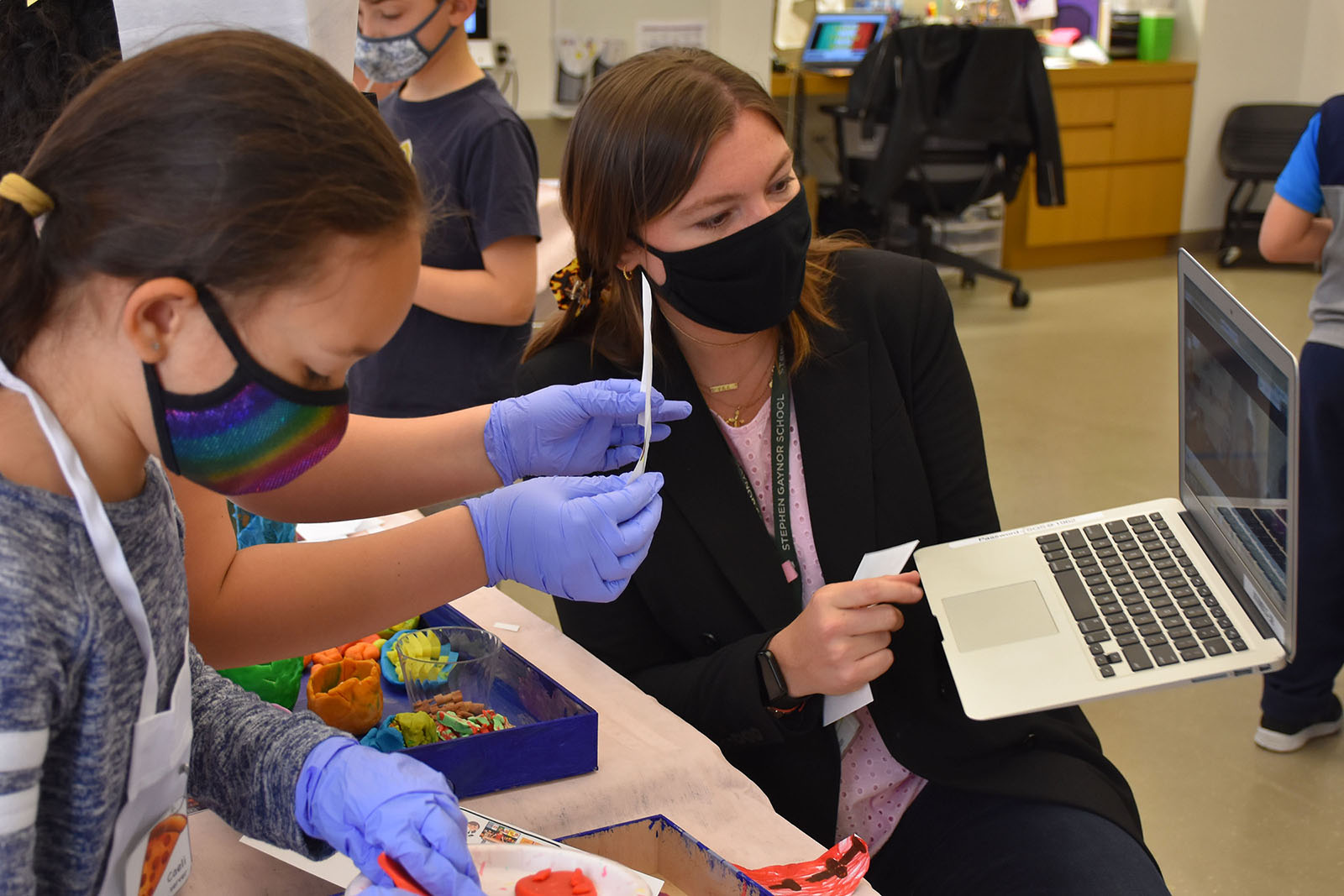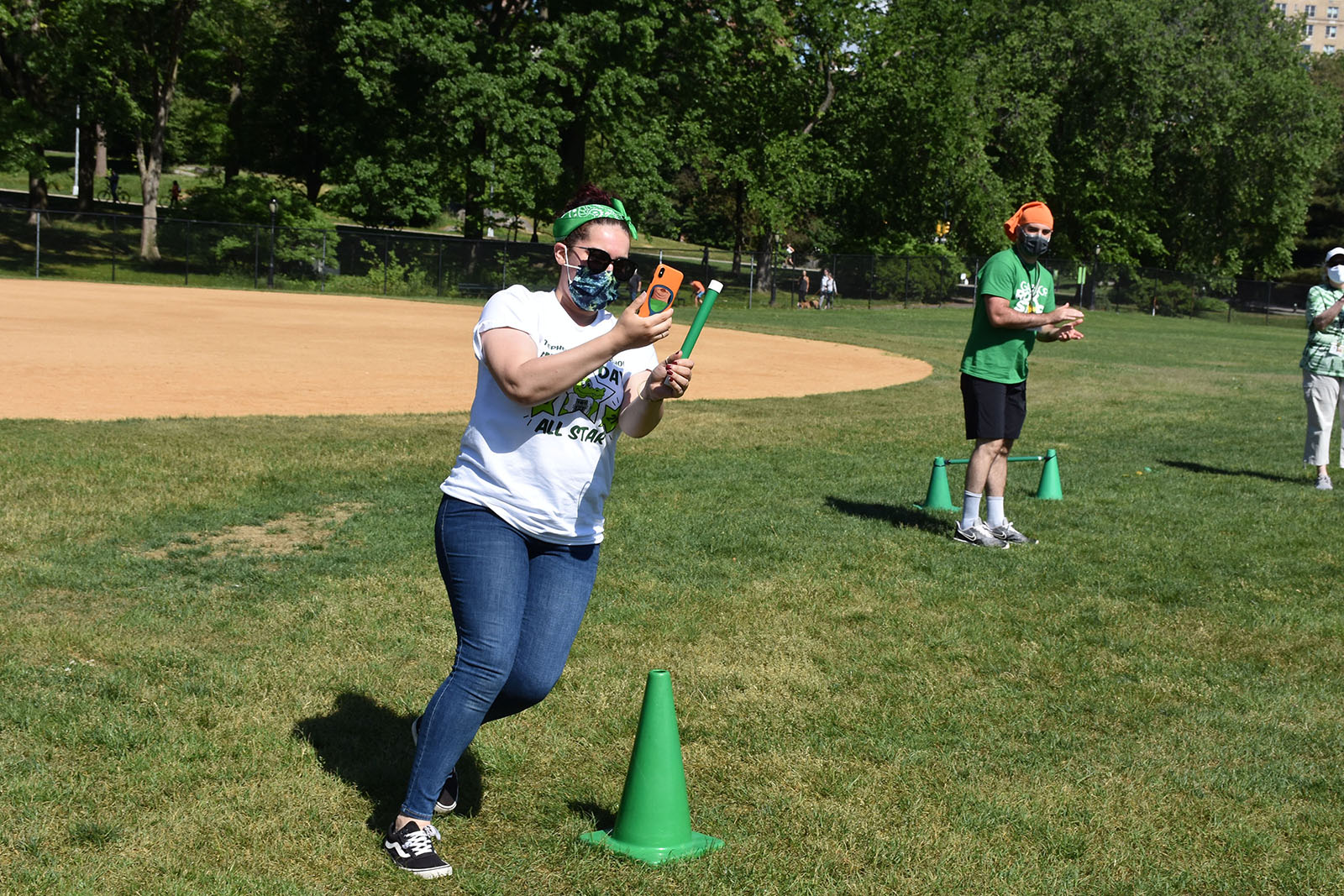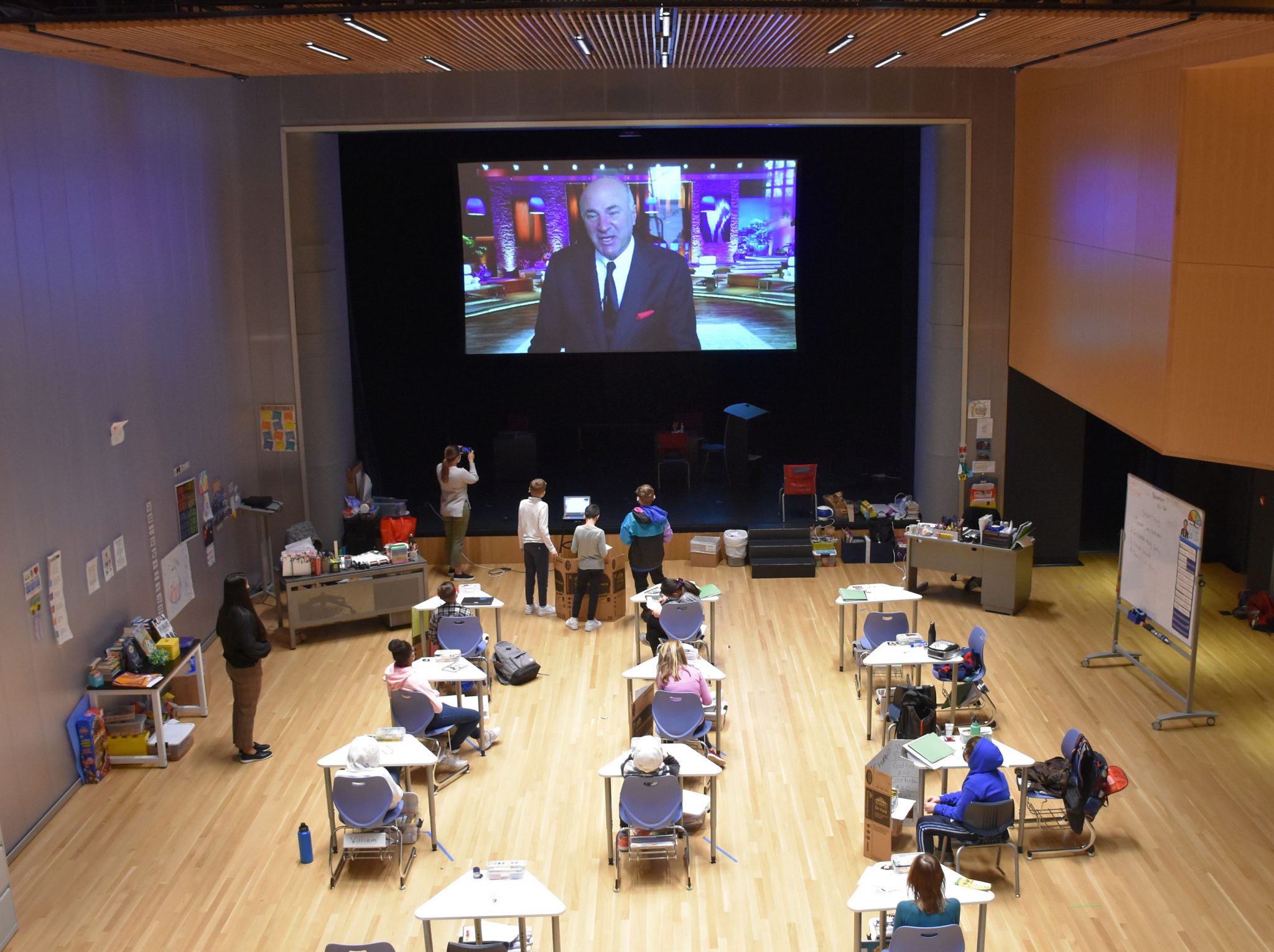This article originally appeared in the Summer 2021 edition of the Gaynor Gazette
An inside perspective on teaching during the pandemic.
 This fall at Stephen Gaynor School, the doors opened once again to welcome students back into classrooms.
This fall at Stephen Gaynor School, the doors opened once again to welcome students back into classrooms.
While that sentence is easy to write, the work of preparing to open schools during a pandemic was difficult and unprecedented. School leaders spent months determining the layers of defense necessary to keep students and staff safe, while teachers and specialists faced many challenges as they got ready for a school year like no other.
Teaching during a pandemic required educators around the globe to learn new skills and wear even more hats than they did before, all while facing health and safety concerns in an uncertain world to be there for their students. Gaynor teachers in particular needed to rededicate themselves to fulfilling the school’s mission of providing a “highly individualized educational program” for each student, and figuring out how they could do that under unique and challenging circumstances.
In November 2020, we interviewed Gaynor teachers to get their perspective on what it was really like to teach onground and remotely during the height of the pandemic. These interviews were conducted before vaccines were approved for emergency use in December, when cases in New York were rising steadily before peaking in early January 2021, and before mass vaccinations began to turn the tide toward our collective recovery from the COVID-19 pandemic.
Of course, as this issue goes to press in the summer of 2021, there are still unknowns — will cases continue to drop, will students under the age of 12 become eligible and begin receiving the vaccine — but there is a feeling of hope that the 2021-2022 school year will feel much more “normal” with regard to teaching and learning.
We thought it was important to capture the thoughts and emotions of Gaynor teachers in the moment, before time and perspective dulled their memories and perceptions of the challenges to being a teacher during the pandemic.
One of the key layers of defense to Gaynor’s onground program in the fall was the “pod model,” which created pods of approximately 12 students and 3 teachers/specialists who would remain in a “bubble” to mitigate the risk of spreading COVID-19 in the school. While the pod model worked from a safety perspective, it did present a challenge to teachers as they learned to navigate this new situation.
“There are so many more contingency plans you have to be ready for,” said Silver Cluster Head Teacher Audrey
Shaefer. “Teaching just isn’t the same right now.”
Ms. Schaefer experienced the new demands from the pod model as she juggled her pod being in two separate rooms and students being in-person as well as remote. She also spoke about the challenges to balancing home and work when it seemed work was always “on” — a feeling familiar to many of us during the pandemic.
“It was always about the whole child, but that is just so much more at the front of your mind than it ever has been,” she said. “And out of the care that you have for your students, it’s really hard to ever accept anything that’s not perfect or that’s not fully fleshed out, while also making sure that somehow you’re leaving time for yourself.”
 These sentiments were echoed by Purple Cluster Head Teacher Brittany Smith. She said for her the biggest struggle was maintaining the level of teaching that she normally could provide while recognizing what was logistically, and emotionally, possible this year.
These sentiments were echoed by Purple Cluster Head Teacher Brittany Smith. She said for her the biggest struggle was maintaining the level of teaching that she normally could provide while recognizing what was logistically, and emotionally, possible this year.
“I knew the things that worked, and I know what the students think is fun, and I know what’s engaging, but how am I going to do that six feet apart, spread across the room, not using hands-on manipulatives?” Ms. Smith detailed some of the many questions she faced as she prepared for the start of the school year. “And I think overall, the biggest struggle continues to be am I doing enough, and am I doing the right things, and what more could I be doing? I think that’s always the struggle of a teacher, but it’s on steroids this year.”
As teachers around the world contended with changing their content and pacing, as well as taking on more roles, they also needed to incorporate new, often untested technologies — the phrase “building the plane as you fly it” was a pandemic mantra.
Red Cluster Head Teacher Jordan Thaler said the necessary technologies of the pandemic — Google Meets, Zoom, Owl cameras in the rooms — did not change the quality with which she w anted to teach, nor did it change the relationships with her students, but it made it harder to do both of those things.
“The school has done so much to make sure we have up-to-date technology, and even still, it’s not infallible,” she said.
The idea that space can have an impact on teaching and community building was ever present this year and affected teachers in challenging and in surprisingly positive ways.
Yellow Cluster Head Teacher Allison Pearlman’s class took place in a very different setting this year — a Ballet Hispanico dance studio. While it may have seemed strange at first, she said the room actually helped provide a positive base for her to build a safe and welcoming classroom environment.
“I definitely think that there’s already so much that goes into the job that we’re doing here, and it’s just been amplified with the pandemic,” Ms. Pearlman said. “But I also think that I feel so fortunate that if we do have to be here, that I’m in Ballet Hispanico. My whole class is in one big space. I have an amazing pod team. I feel very fortunate about that, because it really just lets the focus be on the kids and the relationships and the instruction. That environment makes it much more pleasant here, and we can really get what we need done.”
Keeping students safe while also making sure that they are engaged, happy, and learning was particularly tricky during the pandemic. While teachers at Gaynor have always incorporated social-emotional learning into their curriculums with the implementation of methods such as RULER, this year these concepts became even more important.
Orange Cluster Head Teacher Miriam Filer said giving her students comfort and security was a driving factor in her classroom. One way she incorporated social-emotional learning was by having students give each other shout outs every Friday. In this way, the students acknowledged one another and were praised for things they did that week.
“At the end of the day they’re going to learn to read,” she said. “They’re going to learn to do all these other things, but I wanted them to walk out of this feeling OK. Some kids don’t have siblings, some kids have lots of stuff going on, and I think it was our job here to maintain that level of security and make them feel good.”
The pandemic also impacted students’ ability to socialize with their teachers and each other — an important part of children’s lives.
This was not lost on Gaynor teachers, and despite all of the uncertainty, Pink Cluster Head Teacher Megan Scanlon said she was happy to be there for her students, both in person and through the screen.
“I think that I have learned how important it is for children to have their teachers in their lives and how important it is for children to be able to socialize with each other and their teachers,” she said. “I would say it’s comforting to be able to be in their lives during the pandemic while I’m also dealing with, just like everybody else, everything that’s going on in our world. I think that they need school and they need us, and we as teachers also really need them.”
Green Cluster Head Teacher Nicole Goldman said being in person with her students again allowed her to soak in every moment, and try to provide normalcy and a safe space for them in a year that was far from normal.
“With all this uncertainty in our world, it gives me joy to be there for my students and see their smiling faces each day,” she said. “I’m always eager to do more for my students, especially now. I just want to see them continue to grow in spite of the circumstances that we’ve all been dealing with.”
Teachers also grappled with coming to work in person, wanting to remain safe while also understanding how important in-person instruction is for Gaynor students.
Ms. Pearlman said teaching during the pandemic was, in part, about the emotional connection and genuine love teachers have for their students, and wanting to be present for them.
“Academics can be delivered over the screen,” she said. “But to come to work everyday and put on a brave face to be there for your students just shows how much teachers want to restore some sense of normalcy. With all the uncertainty, there was — and I’m only a fourth year teacher, so I can only speak to my experience — but there was no point in this entire process where I even questioned whether or not I would come back in person.”
Ms. Smith said that while she was nervous to come back and teach in person, it was amazing to have students back in her classroom, and she really saw the benefits of in-person instruction.
 “I think I’ve realized even more the importance of, specifically, our jobs at Stephen Gaynor School and the specific students and needs that we address,” she said. “I think also I feel like the wins almost feel more exciting than they did. If you’re doing a lesson online or even if you’re doing a lesson in person, socially distanced, if it’s a success, it almost feels like more of a success because you know how hard it was to create it or to implement it.”
“I think I’ve realized even more the importance of, specifically, our jobs at Stephen Gaynor School and the specific students and needs that we address,” she said. “I think also I feel like the wins almost feel more exciting than they did. If you’re doing a lesson online or even if you’re doing a lesson in person, socially distanced, if it’s a success, it almost feels like more of a success because you know how hard it was to create it or to implement it.”
To Blue Cluster Head Teacher Rebecca Felt, this experience has shown how collaborative a profession teaching is. Teaching requires a lot of emotional energy, so she said being able to rely on colleagues has helped provide her with the emotional support and energy she needs so she can give that back to the students.
She also said that this has shown just how resilient the students are, and how they are sometimes able to better navigate all of the uncertainty than the adults.
“I think the students have been so resilient in the sense that all of us like to know what’s happening next, and our kids have had to sit with this experience of not knowing what school is going to look like, not knowing when we might go virtual at any moment,” Ms. Felt said. “And I think that’s really part of the cornerstone of being at Gaynor too, is we really work with students. Our students are by nature resilient, based on their previous experiences or based on how learning is hard. I think that our kids were set up to be very resilient during this pandemic.”
For Ms. Thaler, in-person instruction brought the joy back to her classroom. A child smiling with a friend on the computer is not the same as two children playing Legos in the classroom space, laughing together, and so she was happy to be there for her students in person.
“Right now I feel both grateful and exhausted,” Ms. Thaler said back in November. “It has reminded me of the importance of being a teacher and showing up every day, because seeing how elated my students are to be in the classroom, I know they need us here if it’s safe and we are able.”
At the time, Ms. Filer was looking forward to distance learning for the weeks after Thanksgiving to see a new side of her students.
“I think one of the things I want people to know is that this experience [of distance learning] gave us a full picture of the students,” she said. “It gave us an understanding of where they lived and what they did and what they were interested in. They were able to share in a way that they weren’t able to share before, and that added a level of personality and character to each of the kids. Kids are so much more than who they are in school, and so this really gave a more rounded picture of who they are.”
Ms. Schaefer summed up what many teachers were feeling in November of 2020:
“How do I feel about teaching now?” Ms. Schaefer asked. “That changes by the minute. There are minutes where it feels incredibly overwhelming when you are wearing 50 more hats and you don’t have enough time during the day and somebody needs a bandaid. There are also the really wonderful, human moments where we are focusing on community building and just becoming better people, and being more patient with ourselves and others.”
Now that the school year is complete, and some of these feelings and experiences are already fading into memory, the efforts of Gaynor teachers, faculty, administrators, and staff, will translate into children who have fond memories of learning and growing during this unprecedented school year.
